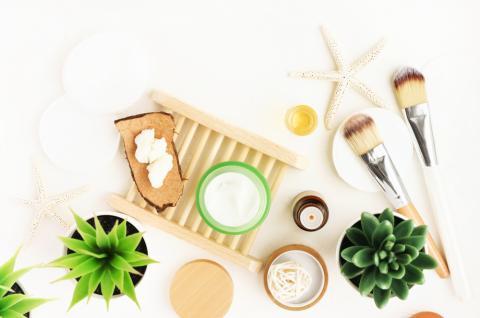
Makeup isn’t exactly the best thing for the environment. Between the plastic containers it comes in and the questionable ingredients, it’s certainly not the greenest thing out there. That said, you don’t have to give up makeup to be green, or care about the environment. You can make the switch to eco-friendly makeup products that don’t harm the environment, or your health. Here’s how to build an eco-friendly makeup routine.
1. Opt For Bamboo Makeup Brushes
Conventional makeup brushes are made from cheap plastic that’s detrimental to the environment. You should instead look for makeup brushes made from recycled or sustainable materials, like bamboo. Bamboo is an amazing material because it grows back so quickly after being cut, making it renewable. Unlike trees which take years to grow, bamboo can grow to their full height in a single growing season of three to four months. That’s pretty impressive.
You should opt for bamboo makeup brushes whenever you need to purchase a new brush. If you currently have brushes that aren’t made from bamboo, but still hold up well, don’t throw them out. That would be wasteful. Wait until the brushes you have need to be replaced before getting new ones.
2. Think Sustainable Packaging
It’s really important to think about packaging. Most makeup is packaged rather excessively with tons of plastic—from the actual plastic container it comes in, to the plastic container it’s made from. Not to mention when you order makeup online, it’s probably going to be shipped in a plastic envelope that’s really hard to recycle. And once your makeup is empty, it’s not very easy to recycle because it’s made from plastic and on the smaller side (which can get easily lost at a recycling facility). This means we truly have to start thinking about how our makeup is packaged and brought to us.
I recommend opting for products with minimal and sustainable packaging. Look for makeup brands that use glass, aluminum, bamboo, or paper in their packaging. These materials are easier to recycle, and you can reuse a lot of them for your own DIYs when they’re empty. In addition to larger national brands, you can find a lot of amazing brands on Etsy that use recyclable or compostable packaging.
3. Choose Organic Ingredients
Along with reducing packaging waste for cosmetics, it’s important to also know what’s in your makeup products. Conventional beauty uses a lot of questionable ingredients that’s not only bad for your health, but bad for the environment, too. Not sure if you know this, but the disposal of cosmetics leads to toxic pollution. It’s the primary cause for contamination of fresh and ocean waters in industrialized nations. Yuck. Sadly, water treatment plants aren’t able to break down the majority of toxins we’re dumping into them. It really does make you wonder what’s exactly in your makeup, right? Well, instead of second guessing, you should make the switch to natural, organic ingredients.
When purchasing makeup, always make sure to read the ingredient label, just as you would with food. Look for brands that utilize ingredients found in nature, and ingredients you can actually read and understand. If you can’t read an ingredient because it sounds like a chemical, chances are you should avoid it. You might even want to look it up to see what it does.
4. Try DIYs
When in doubt, DIYing your makeup is another great option. It’s not too hard to make your own cosmetics, as long as you’re patient and do the research. When you DIY your own products, you have complete control of the ingredients and the packaging. I recommend buying your DIY ingredients as package-free as you can, preferably from a bulk food store. If you can’t find a bulk food store near you, and can’t get an ingredient package free, then try buying the biggest package you can afford to reduce waste and make it easier to recycle. A lot of times health food stores sell ingredients needed to make lots of fun DIYs. As far as the actual packaging goes for your DIYs, you can reuse empty makeup containers you have around the house to store them, or purchase little tins. It depends on what you’re making, ultimately.
Here are some fun DIYs to try for yourself:
5. Recycle Your Makeup
This is the tricky part: Recycling makeup isn’t easy or straight forward. Makeup products are often made from cheap plastic that’s hard to recycle in and of itself. It doesn’t help that makeup products are on the smaller side and tend to get lost in the recycling. The best thing you can do is find a recycling program that’s strictly for makeup products. Origins will recycle used makeup products from any brand if you drop them off. You’ll have to find an Origins near you to do this: I recommend calling them up first and double-checking their makeup recycling program is available. Another option is to participate in TerraCycle’s personal care and beauty recycling program. You can recycle skin care, hair care, and cosmetic packaging through this program for free. Just be aware that there aren’t always slots available so you might have to wait and save your empty makeup containers until a slot opens up. L’Occitane has also partnered with TerraCycle and you can drop off your used beauty and skincare products with them too. They’ll accept any brand, including their own.
6. Simplify Your Makeup Routine
Overall, you should really look to simply your makeup routine. You truly don’t need hundreds of products to look amazing. Having a few products that work and do the job is much better than a bunch you rarely use that gather dust on your shelves. When a new product comes out, avoid the temptation to impulsively buy it: Stick to what’s been working for your skin. Use up whatever you have before buying more. Look to buy multi-use products you can use on your lips, cheeks, and eyes. This will mean less waste and save you money in the long run. You’ll also feel a lot happier when you stop caving into consumerism and start being happy with the products you do have.








